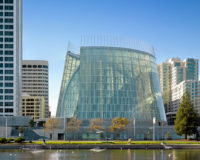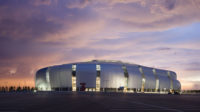PeopleArchitect: Snow Kreilich Architects Inc. Design Architect: Snow Kreilich Architects Architect of record: Ryan A+E Sports Architect: AECOM Engineers: Mechanical Engineer: Schadegg Mechanical, Inc. Consultants Design landscape architect: Bob Close Studio General contractor: Ryan Companies Photographer: Paul Crosby & Christy Radecic Client: City of St. Paul and the St. Paul Saints Size: 347,000 square feet Cost: $63 million Completion date: May 2015
|
ProductsStructural System Structural System: http://www.cmf-inc.com provided structural steel, http://www.amerectinc.com erected the structural steel Exterior Cladding Masonry: Masonry: Custom block supplied by Amcon Block http://www.amconblock.com, http://sericeconstruction.com installed masonry Metal panels: Metal: MG McGrath Inc. Miscellaneous Metals were by http://metro-mfg.com see exterior wall systems for metal panels by http://mgmcgrath.com Precast concrete: http://www.ryancompanies.com for placement and finishing, http://www.avrconcrete.com - supplied ready-mix concrete, Wood: Ceilings (wood): MG McGrath Inc. http://mgmcgrath.com installed western red cedar with clear finish as furnished by Weekes Forest Products http://www.weekesforest.com Other cladding unique to this project: Metal: MG McGrath Inc. Miscellaneous Metals were by http://metro-mfg.com see exterior wall systems for metal panels by http://mgmcgrath.com Glazing Glass: Empirehouse, Inc. http://www.empirehouse.com; Oldcastle BuildingEnvelope (glass, storefront, curtainwall and operable windows at press/media area); Wasco (skylight); Insulgard (ticket windows) Interior Finishes Acoustical ceilings: Acoustical System: http://www.archsalesmn.com Armstrong for ACT ceilings, Sonex for the acoustic foam material in the Saint’s office on the Service Level, MG McGrath Inc. http://mgmcgrath.com installed custom acoustic wood ceiling in Securian Club Room Cabinetwork and custom woodwork: Millwork: Artifex Millwork Inc. http://www.artifexmillwork.com Paints and stains: Paints and Finishes: http://www.rainbowincmn.com majority of the paint is Sherwin Williams through-out (interior/exterior) Lighting Dimming system or other lighting controls: Lighting Control Systems: http://www.huntelec.com installed lighting systems including local controls (wall switches and light sensors). Some of the lighting control was also provided by Humeratech through the building management system. Energy Photovoltaic system:Photovoltaics or other Renewables: http://www.huntelec.com Hunt installed the entire solar array (PV systems), structure is by Presidential Steel Buildings, PV panels are by Sun Power |
Background Notes: The Parthenon and its Panathenaic Frieze
As would be expected, the opening of the New Acropolis Museum has re-ignited the debate about the return of the Parthenon’s so-called Elgin Marbles to Athens. At the opening on June 21 of the museum designed by Bernard Tschumi Architects, the president of Greece, Carolos Papoulias, said of the marbles currently lodged in the British Museum, “It’s time to heal the wounds of this monument [the Parthenon] with the return of the marbles that belong to it.” This “wound” is all the more noticeable by the dramatic display of actual and cast pieces from the Parthenon’s pediments, metopes, and the Panathenaic Frieze on the top floor of the new structure. And because of the brouhaha, curiosity about the marbles themselves has mounted.
In the first decade of the 19th century Thomas Bruce, the 7th earl of Elgin, removed 247 feet of the original 524-foot frieze, 15 of the 92 metopes, and 17 figures from the pediments, plus other architectural elements, and took them back to England. As British Ambassador to the Sublime Porte of Constantinople (Istanbul) where the Ottomon court, which then ruled Greece, was located, Lord Elgin had the opportunity to study the treasures surviving from the famous edifice. While the Parthenon suffered much wear and tear over the years since it had been erected during the age of Pericles (447-432 B.C.), it was most heavily damaged in 1687, when Athens, under Ottoman rule, was besieged by the Venetians. To stave off the Venetians, the Ottoman Turks turned the Acropolis into a fortress, and converted the Parthenon, (which had already functioned as a church and mosque) into a storage facility for gunpowder. When the Venetian camp fired a mortar from a nearby hill, it almost destroyed the classical structure.
During the 18th century, a deep interest in classical antiquity developed among travelers and archeologists—particularly from Britain and France—who came to study the ruins. James Stuart and Nicholas Revett’s measured drawings of the Parthenon, published in 1787 (in volume II of Antiquities of Athens Measured and Delineated) captured the scholarly imagination. At first it seems that Lord Elgin was intent only on drawing and making casts of the Parthenon marbles for interested parties back in England. But soon he began to remove the actual marbles, cutting them into thinner panels so they could be transported more easily. Lord Elgin needed permission to do so, of course, and obtained what he represented as a firman or edict from the Ottoman government saying it was fine to undertake such a project. That firman is disputed even now, Jenifer Neils writes in The Parthenon Frieze (2001), since the actual document is said to be missing, and only an Italian translation exists.
After the British Museum bought the marbles from Lord Elgin in 1816 and put them on display, the museum made casts of its treasure: indeed when Greece was given its independence in 1830, the museum presented the king of Greece with a full set of casts of the Parthenon trove. They arrived in Greece in 1846. Many observers have long considered Lord Elgin’s removal of so many of the real marbles a beneficent act ensuring that these treasures would be safe from more marauders and further destruction. But times change.
Even before the Parthenon of Pericles, the temples on the Acropolis had been subject to destruction. One, the Hekatompedon, thought to have been built on or near the same site as the Parthenon in 570-566 B.C., has few traces left, save for some pedimental sculptures, which can be seen in the New Acropolis Museum. The Parthenon itself rests on the foundations of a subsequent temple, called the “Older Parthenon,” begun in 489 B.C. in celebration of the victory over the Persians in 490 B.C. at Marathon. However, when the Persians returned ten years later, construction halted, and didn’t resume until 468 B.C. at the initiative of Cimon, then Athens’ leading statesman. The temple was only half-finished when he died in 450. After Pericles took over the Parthenon’s construction in 447 B.C., he had Ictinos design a larger temple on the foundations. Whereas the older temple’s peristyle was composed of 6 columns on the short ends and 16 on the long elevations, the new version by Ictinos was expanded to 8 by 17 columns. Callicrates was also involved, but according to Jeffrey Hurwit (The Acropolis in the Age of Pericles, 2004), he was probably the general contractor, and Ictinos remained responsible for the creative work.




Post a comment to this article
Report Abusive Comment